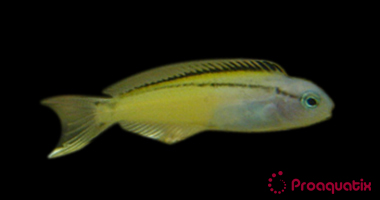Blackline Blenny (Meiacanthus nigrolineatus)
Description:
This species has a blue-teal head that blends into a yellow tail. Black spots are located along the anterior (near the head) dorsal fins, confined only to the soft tissues that inter-digit the fin rays. The common name is derived from a prominent black stripe which originates from the eye and runs longitudinally about half or two-thirds the length of the body, where it becomes a broken line before terminating. Some geographic variants exist.
Natural Ecology:
Meiacanthus nigrolineatus is a carnivore of zooplankton and other bite-size invertebrates. Like most members of this genus, they have evolved a stinging bite for protection against predators. They have also evolved bright colors as an effective reminder to predators, who distinctly associate this species with a stinging experience. Interestingly, other non-venomous species have evolved to look like some Meiacanthus species in color and shape, so that predators also avoid them. The Meiacanthus nigrolineatus is mimicked by Ecsenius gravieri who is a harmless herbivore.
Indigenous To:
This species occurs in the Red Sea and the Gulf of Aden.
Behavior:
This species ignores other species. They are often present in mid-water, hovering near its favorite rock crevice.
Compatibility:
Usually ignores corals and most invertebrates.
Food:
Proaquatix specimens have been weaned to take aquarium pellets and flakes. Freshly frozen invertebrates such as ocean plankton, Mysis shrimp, brine shrimp, and chopped squid.

